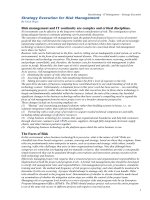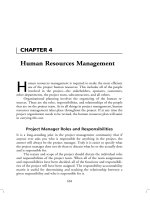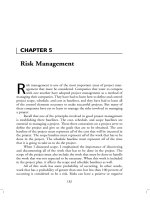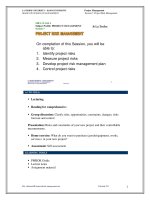Risk Management: Challenge anh Opportunity pptx
Bạn đang xem bản rút gọn của tài liệu. Xem và tải ngay bản đầy đủ của tài liệu tại đây (18.97 MB, 841 trang )
Risk Management
Second Revised and Enlarged Edition
Michael Frenkel ´ Ulrich Hommel
Markus Rudolf
(Editors)
Risk Management
Challenge and Opportunity
Second Revised and Enlarged Edition
With 100 Figures
and 125 Tables
12
Professor Dr. Michael Frenkel
Professor Dr. Markus Rudolf
WHU
Otto Beisheim Graduate School of Management
Burgplatz 2
56179 Vallendar
Professor Dr. Ulrich Hommel
EUROPEAN BUSINESS SCHOOL International University
Stiftungslehrstuhl
Unternehmensfinanzierung und Kapitalmårkte
Schloss Reichartshausen
65375 Oestrich-Winkel
Cataloging-in-Publication Data
Library of Congress Control Number: 2004114544
ISBN 3-540-22682-6 Springer Berlin Heidelberg New York
ISBN 3-540-67134-X 1st edition Springer Berlin Heidelberg New York
This work is subject to copyright. All rights are reserved, whether the whole or part of
the material is concerned, specifically the rights of translation, reprinting, reuse of illus-
trations, recitation, broadcasting, reproduction on microfilm or in any other way, and
storage in data banks. Duplication of this publication or parts thereof is permitted only
under the provisions of the German Copyright Law of September 9, 1965, in its current
version, and permission for use must always be obtained from Springer-Verlag. Violations
are liable for prosecution under the German Copyright Law.
Springer is a part of Springer Science+Business Media
springeronline.com
° Springer Berlin ´ Heidelberg 2000, 2005
Printed in Germany
The use of general descriptive names, registered names, trademarks, etc. in this publica-
tion does not imply, even in the absence of a specific statement, that such names are
exempt from the relevant protective laws and regulations and therefore free for general
use.
Hardcover-Design: Erich Kirchner, Heidelberg
SPIN 11308300 43/3130-5 4 3 2 1 0 ± Printed on acid-free paper
#9QTFQH)TGGVKPI
In my "Word of Greeting" of the first edition of this book which was dedicated to
Günter Dufey, I pointed out that I appreciate Günter Dufey as someone who builds
bridges between Germany and the United States. Meanwhile, almost 5 years have
gone by. Günter Dufey's significance as an academic intermediary between the
continents has even increased since then. Due to his efforts, the cooperation be-
tween high ranked U.S. business schools and the WHU - Otto Beisheim
Hochschule in Germany have been intensified. The joint summer MBA program
on the WHU campus is attended by 45 U.S. students every year. This number is
still growing. Moreover, since the issue of the first edition, Günter Dufey has
enlarged his activity spectrum also to Asia. In 2002 until 2003 Günter Dufey
joined the Singapore Office of the firm as Senior Advisor, supporting the Corpo-
rate Governance Practice of the firm in the Region. Since then he was appointed
as Professor of Banking and Finance at the Nanyang Business School - Nanyang
Technological University and as Principal of the Pacific International Business
Associates. Last but not least, he is now an ordinary member of the Singapore In-
stitute of Directors.
It is impressive to see the energy and the enthusiasm with which Günter Dufey
travels restlessly around the world, once eastwards, another time westwards.
Without any doubt, it is quite unusual that a Festschrift sells out. The first edition
of this book has been written by a global selection of financial experts. They
wanted to act as a sign of friendship by honoring Günter Dufey's 60th birthday. I
am very happy, that the first edition was so successful because this indicates also
the importance of the book' content.
Much has been changed in the field of risk management since then. Probably
most significantly, there has been an intensive discussion between financial insti-
tutions dealing with modified rules of determining the adequate amount of equity
capital for risks. The committee of banking supervision located at the Bank of In-
ternational Settlement in Basel, Switzerland, has initiated several proposals known
under the short form "Basel II". One of the core questions in the context of these
capital adequacy rules is the capital requirement for credit risks. According to
Basel II, in the future this will be closer related to the rating of transaction coun-
terparties enhancing the role of the rating process and the rating industry. Another
important risk category which is addressed by Basel II for the first time is opera-
tive risk. The terror attack on the World Trade Center on 11 September 2001
showed drastically how significant external and unpredictable events can be on the
operations of any company, particularly of banks. Moreover, risks form internal
processes, people, or systems contribute to the success or to the failure of the
business. All these risks are summarized as new risk type in Basel II, namely as
VI A Word of Greeting
operative risk. Operative risk is much more difficult to measure than credit and
market risks. But they nevertheless affect the performance of financial institutions.
The deadline for implementing Basel II in national laws is year-end 2006. It is
obvious that this development is intensively covered in the second edition of the
book. I hope that this book will help to understand the complex and new aspects of
risk management better. And I am happy that such an instructional content is asso-
ciated to the name of my former student in Würzburg, Günter Dufey.
Otmar Issing
2TGHCEG
Michael Frenkel, Ulrich Hommel, Markus Rudolf
The success of the first edition of this book encouraged us to update and extend
this volume in order to provide an up-to-date and comprehensive survey of the
major areas of risk management issues. Since the first edition of this book, a num-
ber of changes in the area of risk management took place. Some of them are re-
flected in the discussions on the “Basel II” rules. The new edition takes these new
developments into account. Given the wider scope of the new edition, we decided
to structure the book according to the type of risk management the various aspects
are most narrowly related to. More specifically, we distinguish four broader top-
ics. Part 1 focuses on bank risk management, part 2 on insurance risk manage-
ment, part 3 on corporate risk management, and part 4 on systemic issues of risk
management. In the following, a very brief outline of the papers is presented.
Part 1 begins with the analysis by Thomas Hartmann-Wendels, Peter Grundke
and Wolfgang Spörk of the Basel II rules and their consequences on bank lending.
Then, Ingo Walter looks at conflicts of interest involving financial services firms.
He shows the conditions that can cause or limit exploitation of conflicts of interest
and argues that external regulation and market discipline can be both complements
and substitutes. A normative theory or risk management in banks is the subject of
the contribution of Gerhard Schröck and Manfred Steiner. Then, Claudia Holtorf,
Matthias Muck and Markus Rudolf present a case study that analyses the new
Basel capital accord requirements by applying the RiskMetricsTM. Value at Risk
is the core of several papers in part 1. Alois Paul Knobloch surveys applications of
this concept for risk measurement purposes; John Bilson uses to concept to review
fixed income portfolios, Robert Härtl and Lutz Johanning examine risk budgeting,
and Jack Wahl and Udo Broll examine the implications of Value at Risk for the
optimum equity level of a bank. Wolfgang Drobetz and Daniel Hoechle compare
alternative estimates of conditional return expectations. Subsequently, Ludger
Overbeck surveys modelling of credit risk portfolios. A critical evaluation of
credit risk models is the topic of the paper by Hergen Frerichs and Mark Wahren-
burg. Related to this type of risk is the analysis of Stefan Huschens, Konstantin
Vogl, and Robet Wania, who look at possibilities to estimate default probabilities
and default correlations. The subsequent two papers examine operational risk in
the context of Basel II. While Carol Alexander gives an overview of the different
dimensions of this risk type, Wilhelm Kross addresses practical issues for man-
agement dealing with such risk. In the last paper of this part, Christoph Kaserer,
Niklas Wagner and Ann-Kristin Achleitner investigate possibilities to measure
private equity returns under conditions of illiquidity.
Part 2 focuses on insurance risk management. Martin Nell and Andreas Richter
discuss three issues related to the management of catastrophic risk which stem
from the terror attacks of September 11, 2001. Subsequently, Christopher Culp
surveys products and solutions that represent the convergence or integration of
VIII Preface
capital markets and traditional insurance. Such products are referred to as alterna-
tive risk transfer. Ulrich Hommel and Mischa Ritter address a similar area of risk
management. They analyze the main forces behind the securitization of catastro-
phic insurance risk and derive conclusions as to how other forms of insurance can
be transferred to financial markets. In recent years, demographic changes in a
number of advanced economies have been discussed intensely. The paper of Petra
Riemer-Hommel and Thomas Trauth addresses this issue by analyzing possibili-
ties of managing longevity risk associated with pension, annuity and long-term
care products. Particularly in the German market, another problem of life insur-
ance companies generate from unknown capital market developments and the si-
multaneously issued interest rate guarantees of traditional life insurance products.
Peter Albrecht and Carsten Weber investigate the implications of this constellation
on the asset allocation decision.
Part 3 includes papers that discuss a variety of issues of corporate risk manage-
ment. In the first paper, Fred Kaen addresses the relationship between risk man-
agement and corporate governance and makes the point that risk management not
only helps a firm to survive but also serves broader policy objectives. In the next
paper, Christian Laux examines how corporate risk management can be integrated
into the objective of maximizing firm value. Subsequently, Ulrich Hommel inves-
tigates the more fundamental question why the management of corporate risk
should be managed at all and why it should be managed on the firm rather than the
investor level. Focusing on a German regulation requiring firms to implement risk
management systems, Jürgen Weber and Arnim Liekweg discuss critical imple-
mentation issues for non-financial firms. How risk analysis and risk aggregation
enters value-based corporate risk management is the topic of the paper by Werner
Gleißner. A more macroeconomic focus of risk is presented by Lars Oxelheim and
Clas Wihlborg who emphasize the importance of exchange rates, interest rates and
inflation rates in estimating corporate risk. This issue is taken one step further in
the paper of Matthias Much and Markus Rudolf as they include international is-
sues of corporate risk management. They use the case study of three airlines to
emphasize commodity and exchange rate risk and show the effects on corporate
risk by applying the “Earnings at Risk” concept. A consequence of corporate risk
is the use of financial derivatives in risk management. In this context, real options
represent alternatives to financial hedging. The paper of Alexander Triantis uses a
specific example to discuss the implications of these alternatives. Operational and
managerial flexibility in international supply chains also contribute to real options.
Arnd Huchzermeier uses a case study to illustrate the value of such flexibility for
risk management. In the international context, exchange rate exposure represents a
major risk, when cross-border acquisitions are considered. Stefan Hloch, Ulrich
Hommel, and Karoline Jung-Senssfelder show that this risk stems from consider-
able time lags between the acquisition decision and its implementation due to, e.g.,
the process of regulatory clearance by the antitrust authorities. In the following
paper, Christian Geyer and Werner Seifert describe electricity derivatives as new
risk classes to organized exchanges and explain why the German Stock Exchange
(Deutsche Börse) intends to establish an exchange for energy derivatives. Foreign
exchange risk is more closely examined in two contributions. While Martin Glaum
Preface IX
presents an empirical study on the measuring and management of foreign ex-
change risk in large German non-financial corporations, Kathryn Dewenter,
Robert Higgins and Timothy Simin show that, contrary to many studies presented
earlier in the literature, there is a negative influence of the value of the dollar and
stock returns of U.S. multinational firms. The subsequent paper by Wolfgang
Breuer and Olaf Stotz addresses the problem of securing the real value rather than
the nominal value of assets in risk management. The last paper of part 3 focuses
on capacity options. Stefan Spinler and Arnd Huchzermeier explain how options
on capacity can be used in capital intensive industries for risk management.
Part 4 focuses on more systemic risk aspects with which firms have to deal in
the national and the international environment. Adrian Tschoegl argues in his con-
tribution that financial debacles in the mid-1990s are the result of management
failures and suggests that risk management has to take into account that such er-
rors are the result of human nature. While this emphasizes a microeconomic ele-
ment of risk management, Michael Frenkel and Paul McCracken show that a cur-
rency union as represented by the European Monetary Union exerts several
additional risks which firms operating in this area have to recognize. Whether risk
management itself makes financial markets riskier is discussed in the paper by Ian
Harper, Joachim Keller and Christian Pfeil. The authors argue that both on theo-
retical and empirical grounds there are indications that this is indeed possible. In
the same direction, Torben Lütje and Lukas Menkhoff analyze risk management
of institutional investors may lead to the behaviour of rational herding. A final
look at systemic risk aspects is presented by Mitsuru Misawa. He looks at the
Japanese experience in the 1990s when financial markets suffered significant
damage due to the burst of the asset price bubble and evaluates Japan’s big bang
financial reform.
Although this book covers a variety of diverse aspects of risk management, no
book on this broad and complex issue can cover all aspects. Therefore, we were
forced to be selective in certain areas. In addition, new topics may come up in the
future, as further risk categories may continue to evolve and both risk manage-
ment and policies will also further develop.
Such a volume cannot be completed without the help of many individuals. We
thank all authors and those that have given us suggestions for the new edition. We
are very grateful to Kerstin Frank who showed enormous commitment and pa-
tience in preparing the manuscript. We are also thankful to Gudrun Fehler for
proofreading a number of papers of this volume and to Martina Bihn representing
the publisher for her support and patience in making this new edition possible.
$TKGH6CDNGQH%QPVGPVU
A Word of Greeting V
Preface VII
Part 1: Bank Risk Management
Basel II and the Effects on the Banking Sector 3
Thomas Hartmann-Wendels, Peter Grundke and Wolfgang Spörk
Conflicts of Interest and Market Discipline in Financial Services Firms 25
Ingo Walter
Risk Management and Value Creation in Banks 53
Gerhard Schröck and Manfred Steiner
The New Basel Capital Accord 79
Claudia Holtorf, Matthias Muck, and Markus Rudolf
Value at Risk:
Regulatory and Other Applications, Methods, and Criticism 99
Alois Paul Knobloch
Parsimonious Value at Risk for Fixed Income Portfolios 125
John F. O. Bilson
Risk Budgeting with Value at Risk Limits 143
Robert Härtl and Lutz Johanning
Value at Risk, Bank Equity and Credit Risk 159
Jack E. Wahl and Udo Broll
Parametric and Nonparametric Estimation of Conditional
Return Expectations 169
Wolfgang Drobetz and Daniel Hoechle
Credit Risk Portfolio Modeling: An Overview 197
Ludger Overbeck
Evaluating Credit Risk Models 219
Hergen Frerichs and Mark Wahrenburg
Estimation of Default Probabilities and Default Correlations 239
Stefan Huschens, Konstantin Vogl, and Robert Wania
Managing Investment Risks of Institutional Private
Equity Investors – The Challenge of Illiquidity 259
Christoph Kaserer, Niklas Wagner and Ann-Kristin Achleitner
XII Brief Table of Contents
Assessment of Operational Risk Capital 279
Carol Alexander
Operational Risk: The Management Perspective 303
Wilhelm Kross
Part 2: Insurance Risk Management
Catastrophic Events as Threats to Society:
Private and Public Risk Management Strategies 321
Martin Nell and Andreas Richter
New Approaches to Managing Catastrophic Insurance Risk 341
Ulrich Hommel and Mischa Ritter
Alternative Risk Transfer 369
Christopher L. Culp
The Challenge of Managing Longevity Risk 391
Petra Riemer-Hommel and Thomas Trauth
Asset/Liability Management of German Life Insurance Companies:
A Value-at-Risk Approach in the Presence of Interest Rate Guarantees 407
Peter Albrecht and Carsten Weber
Part 3: Corporate Risk Management
Risk Management, Corporate Governance and the Public Corporation 423
Fred R. Kaen
Integrating Corporate Risk Management 437
Christian Laux
Value-Based Motives for Corporate Risk Management 455
Ulrich Hommel
Value-based Corporate Risk Management 479
Werner Gleißner
Statutory Regulation of the Risk Management Function in Germany:
Implementation Issues for the Non-Financial Sector 495
Jürgen Weber and Arnim Liekweg
A Comprehensive Approach to the Measurement of
Macroeconomic Exposure 513
Lars Oxelheim and Clas Wihlborg
Foreign-Exchange-Risk Management in German
Non-Financial Corporations: An Empirical Analysis 537
Martin Glaum
Brief Table of Contents XIII
Estimating the Exchange Rate Exposure of US Multinational Firms:
Evidence from an Event Study Methodology 557
Kathryn L. Dewenter, Robert C. Higgins and Timothy T. Simin
International Corporate Risk Management:
A Comparison of Three Major Airlines 571
Matthias Muck and Markus Rudolf
Corporate Risk Management: Real Options and Financial Hedging 591
Alexander J. Triantis
The Real Option Value of Operational and Managerial Flexibility
in Global Supply Chain Networks 609
Arnd Huchzermeier
Managing Acquisition-Related Currency Risk Exposures:
The E.ON-Powergen Case 631
Stefan Hloch, Ulrich Hommel, and Karoline Jung-Senssfelder
Introducing New Risk Classes to Organized Exchanges:
The Case of Electricity Derivatives 651
Christian Geyer and Werner G. Seifert
Was Enron’s Business Model Fundamentally Flawed? 671
Ehud I. Ronn
“Real” Risk Management:
Opportunities and Limits of Consumption-based Strategies 679
Wolfgang Breuer and Olaf Stotz
Capacity Options: Convergence of Supply Chain Management
and Financial Asset Management 699
Stefan Spinler and Arnd Huchzermeier
Part 4: Systemic Issues of Risk Management
The Key to Risk Management: Management 721
Adrian E. Tschoegl
Economic Risks of EMU 741
Michael Frenkel and Paul McCracken
Does Risk Management Make Financial Markets Riskier? 765
Ian R. Harper, Joachim G. Keller, and Christian M. Pfeil
Risk Management, Rational Herding and Institutional Investors:
A Macro View 785
Torben Lütje and Lukas Menkhoff
Revitalization of Japanese Banks – Japan’s Big Bang Reform 801
Mitsuru Misawa
6CDNGQH%QPVGPVU
A Word of Greeting V
Preface VII
Part 1: Bank Risk Management
Basel II and the Effects on the Banking Sector 3
Thomas Hartmann-Wendels, Peter Grundke and Wolfgang Spörk
1. Overview on the New Basel Capital Accord 3
1.1 Why Do We Need a More Sophisticated Banking Supervision? 5
2. The Standardized Approach 6
3. The Internal Ratings-Based Approach 9
3.1 The IRB Approach for the Corporate Asset Class 9
3.1.1 Basic Structure of the IRB Approach for the Corporate Asset
Class 9
3.1.2 The Risk Components 10
3.1.3 The Risk Weight Function 13
3.2 The IRB Approach for the Retail Asset Class 17
4. Consequences of Basel II 19
4.1 Consequences on the Lending Margins 19
4.2 Consequences for the Banking Industry 22
Conflicts of Interest and Market Discipline in Financial Services Firms 25
Ingo Walter
1. A Conflict of Interest Taxonomy 27
1.1 Conflicts of Interest in Wholesale Financial Markets 28
1.2 Conflicts of Interest in Retail Financial Services 31
1.3 Wholesale-Retail Conflicts 33
2. Conflicts of Interest and Strategic Profiles of Financial Firms 36
2.1 Potential Conflicts of Interest in Multifunctional Client
Relationships 37
3. Constraining Exploitation of Conflicts of Interest 40
3.1 Regulation-Based Constraints 40
3.2 Market-Discipline Constraints 43
3.3 Intersection of Regulation and Market-Based Constraints 45
4. Conclusion 47
Risk Management and Value Creation in Banks 53
Gerhard Schröck and Manfred Steiner
1. Introduction 54
2. Necessity for a Framework on Risk Management in Banks
at the Corporate Level 54
3. RAROC as Capital Budgeting Rule in Banks 60
3.1 Evolution of Capital Budgeting Rules in Banks 60
3.2 Definition of RAROC 61
3.3 Assumptions and Deficiencies of RAROC 64
4. Overview of New Approaches 65
XVI Table of Contents
5. Implications of the New Approaches on Risk Management
and Value Creation in Banks 67
5.1 Implications for Risk Management Decisions 68
5.2 Implications on Capital Budgeting Decisions 71
5.3 Implications on Capital Structure Decisions 71
6. Foundations for a Normative Theory for Risk Management in Banks 72
7. Conclusion 74
The New Basel Capital Accord 79
Claudia Holtorf, Matthias Muck, and Markus Rudolf
1. Introduction 79
2. VaR Calculation 81
3. Regulatory Reporting, VaR, and Capital Requirement 89
4. Internal vs. Standard Model 91
5. Credit Risk 94
6. Operational Risk 97
7. Summary and Outlook 97
Value at Risk:
Regulatory and Other Applications, Methods, and Criticism 99
Alois Paul Knobloch
1. The Concept of Value at Risk and its Role in
Contemporary Risk Management 99
1.1 Value at Risk: Definition and Risks of Concern 100
1.2 Applications and Regulatory Background 101
2. Calculating Value at Risk: Methods and Inherent
Sources of Inaccuracy 103
2.1 Delta-normal and Delta-gamma Approach 104
2.2 Simulation Methods: Historical and Monte Carlo Simulation 107
3. Risk Reduction and Capital Allocation Within a Value at Risk
Framework 109
3.1 Minimizing Value at Risk 110
3.2 Allocating VaR to Business Units 112
4. Shortcomings of Value at Risk as a Measure of Risk 114
5. Conclusion 121
Parsimonious Value at Risk for Fixed Income Portfolios 125
John F. O. Bilson
1. Introduction 125
1.1 A Simple Example 126
1.2 The Key Rate Duration Model 130
1.3 The Level, Slope, and Curvature (LSC) Model 133
1.4 LSC Risk Analysis 137
1.5 Conclusion 140
Risk Budgeting with Value at Risk Limits 143
Robert Härtl and Lutz Johanning
1. Introduction 144
2. Definition of Value at Risk Limits 145
3. The Structure of the Simulation Models 147
4. Adjusting Risk Limits for Time Horizons and
Profits and Losses 148
Table of Contents XVII
5. Incorporating Asset Correlations Into Risk Budgets 150
6. Conclusion and Practical Implications 153
Value at Risk, Bank Equity and Credit Risk 159
Jack E. Wahl and Udo Broll
1. Introduction 159
2. A Banking Firm 160
2.1 The Economic Setting 161
2.2 The Stochastic Setting 162
2.3 Value at Risk and the Bank’s Profit 163
3. Optimal Capital Requirement 163
4. Value Maximization and Bank Equity 164
5. Conclusion 166
Parametric and Nonparametric Estimation of Conditional
Return Expectations 169
Wolfgang Drobetz and Daniel Hoechle
1. Introduction 170
2. Parametric versus Nonparametric Regression – A Simple Derivation 172
2.1 Conditional Mean, Econometric Loss, and Weighted Least Squares 172
2.2 The Parametric Approach: An Unusual Representation of OLS 174
2.3 Nonparametric Regression Analysis 176
2.4 The Multivariate Case 181
2.5 Bandwidth Selection for Nonparametric Regression Estimators 182
3. Data Description 183
4. Empirical Results 185
4.1 In-sample Results 185
4.2 Out-of-sample Results 189
5. Conclusion 193
6. Acknowledgement 193
Credit Risk Portfolio Modeling: An Overview 197
Ludger Overbeck
1. Purpose of Credit Risk Modeling 197
1.1 Enterprise Risk Management 197
1.1.1 Economic Capital 198
1.1.2 Capital Allocation 199
1.2 Integration of Risk Types 199
1.3 Loss Distribution 200
1.4 Risk Measure 200
1.5 Portfolio Transactions 201
2. Basic Components of Credit Risk Modeling 201
2.1 Inputs 201
2.1.1 Exposure at Default 201
2.1.2 Loss Given Default 202
2.1.3 Default Probability 202
2.1.4 Dependency Concept 202
2.1.5 Event Versus Time Series Correlation 203
2.2 Output 204
2.2.1 Economic Capital 204
XVIII Table of Contents
2.2.2 Value-at-Risk 204
2.2.3 Expected Shortfall 205
2.2.4 Coherent Risk Measures 206
2.2.5 Capital Allocation 206
2.2.6 Contribution to Volatility and Contribution to VaR,
Capital Multiplier 206
2.2.7 Contribution to Expected Shortfall 207
3. Portfolio Models 207
3.1 Actuarial Approach 208
3.1.1 Specification of Severity and Frequency Distributions 208
3.1.2 Dependence 209
3.1.3 Extensions 209
3.2 Structural Approach 210
3.2.1 Default Event 210
3.2.2 Dependencies 211
3.2.3 Loss Distribution 213
3.2.4 Extensions 215
4. Summary 216
Evaluating Credit Risk Models 219
Hergen Frerichs and Mark Wahrenburg
1. Introduction 219
2. Backtests Based on the Frequency of Tail Losses 221
3. Backtests Based on Loss Density Forecasts 225
4. Forecast Evaluation Approaches to Backtesting 231
5. Conclusion 236
Estimation of Default Probabilities and Default Correlations 239
Stefan Huschens, Konstantin Vogl, and Robert Wania
1. Introduction 239
2. Estimation of Default Probabilities 240
2.1 Single-Period Case 240
2.2 Multi-Period Case 246
2.3 Multi-Group Case 247
3. Estimation of Default Correlation 249
3.1 Concepts of Dependent Defaults 249
3.2 Estimation in a General Bernoulli Mixture Model 250
3.3 Estimation in a Single-Factor Model 253
4. Simultaneous Estimation 255
4.1 General Bernoulli Mixture Model 255
4.2 Single-Factor Model 256
5. Conclusion 257
Managing Investment Risks of Institutional Private
Equity Investors – The Challenge of Illiquidity 259
Christoph Kaserer, Niklas Wagner and Ann-Kristin Achleitner
1. Introduction 260
2. Measuring Private Equity Returns and Risk 261
2.1 Asset Value Based Returns 263
2.2 Smoothed Proxy Observations 264
2.3 Noisy Smoothed Proxy Observations 266
Table of Contents XIX
2.4 Cash Flow Based Returns 267
3. Risk Management and Asset Allocation 270
3.1 Specific Issues in Risk Management 271
3.2 Specific Issues in Asset Allocation 273
4. Conclusion 274
Assessment of Operational Risk Capital 279
Carol Alexander
1. The Operational Risk Capital Model 281
1.1 Frequency, Severity and the Loss Distribution 283
1.2 Operational Risk Capital Calculation 286
2. Dealing with Operational Risk Data 289
2.1 Choosing the Functional Form of the Loss Model 289
2.2 Data Filtering and Scaling 290
2.3 Risk Self-Assessment 293
2.4 Data-Oriented AMA 294
3. Aggregation of Operational Risks 294
3.1 Identification of Dependencies 295
3.2 The Effect of Dependencies on the Aggregate ORC 296
3.3 Aggregating Operational Risks with Other Risks 298
4. Summary and Conclusions 299
Operational Risk: The Management Perspective 283
Wilhelm Kross
1. Introduction 304
1.1 Commonly Practiced Approaches to OpRisk 305
1.2 Pitfalls on the Road to AMA Compliance 306
1.3 Inefficiencies in AMA Compliance Management 310
1.4 Desirable Side-Effects in OpRisk Management 311
1.5 Priorities and Maximized Value in OpRisk Management 313
1.6 Generic Roadmap towards Effective OpRisk Management 315
1.7 Conclusions and Recommendations 316
Part 2: Insurance Risk Management
Catastrophic Events as Threats to Society:
Private and Public Risk Management Strategies 321
Martin Nell and Andreas Richter
1. Introduction 322
2. Insurance-linked Securities 324
3. State Guarantees for Catastrophic Risk? 331
4. Problems with Catastrophe Insurance Demand 335
5. Conclusion 336
New Approaches to Managing Catastrophic Insurance Risk 341
Ulrich Hommel and Mischa Ritter
1. Introduction 341
2. CAT-Linked Securities – A New Asset Class 345
3. Traditional and ART-Based CAT Reinsurance 347
4. Optimizing the Issuer’s Risk Portfolio 350
5. Risk Management Strategies Using CAT-Linked Securities 352
XX Table of Contents
5.1 Ex-Post Capital Provision and Funding Cost Reduction with
CAT-linked Bonds 353
6. Valuation Issues 359
7. Concluding Remarks 361
Alternative Risk Transfer 369
Christopher L. Culp
1. Introduction 369
2. Self-Insurance, Captives, and the Emergence of ART 370
2.1 Single-Parent Captives 371
2.2 Other Captive-Like Structures 373
2.2.1 Mutualized Structures 373
2.2.2 Rent-A-Captives and Protected Cell Companies 374
3. Finite Risk 375
3.1 Typical Finite Risk Structures 375
3.2 Potential Benefits to Corporates 377
3.3 The AIG/Brightpoint SEC Settlement 378
4. Multi-Line Programs and Risk Bundling 379
4.1 Overcoming Silo-by-Silo Inefficiency 380
4.2 A Mixed Record 382
5. Multi-Trigger Programs 383
6. Structured Finance Solutions 384
6.1 Asset Securitization 384
6.2 Risk Securitization 385
6.3 Future Flow Securitization 387
6.4 Structured Liabilities 387
7. Contingent Capital 388
8. Conclusion 389
The Challenge of Managing Longevity Risk 391
Petra Riemer-Hommel and Thomas Trauth
1. Introduction 391
2. Establishing the Relevance of Longevity Risk to the Insurance Industry 392
3. Economic Reasons for the (Re)Insurance Gap 396
3.1 Difficulties in Forecasting Longevity Trends 397
3.2 Adverse Selection 398
3.3 Moral Hazard 399
3.4 Absence of Diversification and Hedging Opportunities 400
4. Possible Solutions for Longevity Risk (Re)Insurance 401
4.1 Pricing to Risk 401
4.2 Finite Reinsurance Solutions 402
4.3 Capital Market Solutions 403
5. Conclusion 404
Asset/Liability Management of German Life Insurance Companies:
A Value-at-Risk Approach in the Presence of Interest Rate Guarantees 407
Peter Albrecht and Carsten Weber
1. Introduction 408
2. The Model and its Calibration 410
3. The Case of German Life Insurance Companies 411
4. Pure Market Values of Assets 412
Table of Contents XXI
5. Book Values of Assets 413
6. The Riskless Asset 414
7. Summary 417
8. Appendix A: Probable Minimum Return 418
9. Appendix B: Worst Case-Average Return 418
10. Appendix C: Conversion of Market Values into Book Values 419
Part 3: Corporate Risk Management
Risk Management, Corporate Governance and the Public Corporation 423
Fred R. Kaen
1. Introduction 423
2. “Scientific” Theoretical Perspective on Risk Management 424
3. From Theory to Practice: Why Firms Should Manage Risk 426
3.1 Using Risk Management to Lower Taxes 426
3.2 Reducing Financial Distress and Bankruptcy Costs 427
3.3 Using Risk Management to Encourage and Protect
Firm Specific Investments 428
3.4 Using Risk Management to Monitor and Control Managers 430
3.5 Using Risk Management to Improve Decision Making
and Capital Budgeting 431
3.6 Risk Management and Dividends 431
4. Back to Berle and Means 432
5. Summary and Conclusions 434
Integrating Corporate Risk Management 437
Christian Laux
1. Introduction 437
2. How Does Risk Management Add Value? 439
3. Measuring the Value of Risk Management 441
4. Identifying a Firm’s Collective Risks 443
5. Interactions Between Risk Management, Financial Structure,
and Operating Decisions 444
6. Integrated Products 446
7. Risk Management and Managerial Incentive Problems 449
Value-Based Motives for Corporate Risk Management 455
Ulrich Hommel
1. Introduction 455
2. The Irrelevance Theorem of Modigliani-Miller (MM) 456
3. Value Based Motives for Corporate Risk Management 458
3.1 Raising the Efficiency of Financial Contracting 459
3.1.1 Shareholders vs. Management 460
3.1.2 Creditors vs. Shareholders 462
3.2 Reducing the Corporate Tax Burden 466
3.3 Reducing Transaction Costs 468
3.3.1 Transaction Cost of Financial Distress 468
3.3.2 Transaction Cost of Hedging 469
3.4 Selecting the Optimal Risk Portfolio 470
3.5 Coordinating Financial and Investment Policies 471
4. Conclusion 474
XXII Table of Contents
Value-based Corporate Risk Management 479
Werner Gleißner
1. Introduction 479
2. Tasks and Elements of Corporate Risk Management – Overview 482
2.1 From Risk Management to Value-Based Management and
Strategic Management 482
2.2 Analyzing Risks 484
2.3 Aggregating Risks: Definition of Total Risk Volume 484
2.4 Coping with Risks 486
2.5 Designing Risk Management Systems and Monitoring 486
3. Risk, Cost of Capital and Shareholder Value 487
3.1 Introducing Considerations, the Shareholder Value 487
3.2 Enterprise Value and Capital Costs in Efficient Markets 488
3.3 Model Criticism 489
3.4 Deriving Realistic Cost of Capital Rates 490
3.5 Further Consequences of Inefficient Capital Markets 491
4. Conclusion 492
Statutory Regulation of the Risk Management Function in Germany:
Implementation Issues for the Non-Financial Sector 495
Jürgen Weber and Arnim Liekweg
1. Introduction: Statutory Regulations as Cause of a
New German Discussion on Risk–Management 495
2. Entrepreneurial Risk and Risk Management: A Holistic Approach 497
2.1 Chance, Risk and their Definitions 497
2.2 Chance, Risk and their Dimensions 498
2.3 The Process of Entrepreneurial Chance and Risk Management 499
2.3.1 The Chance/Risk–Strategy 500
2.3.2 Chance/Risk–Identification 501
2.3.3 The Chance/Risk–Analysis 502
2.3.4 The Chance/Risk–Reporting 503
2.3.5 Chance/Risk–Management 506
2.3.6 Chance/Risk–Monitoring 507
2.4 The Process-External Monitoring and Revision Function 508
3. Summary: The Critical Factors for the Implementation of the
Risk Management Function 508
A Comprehensive Approach to the Measurement of
Macroeconomic Exposure 513
Lars Oxelheim and Clas Wihlborg
1. Introduction 513
2. Exposure Coefficients 515
3. The Choice of Dependent Variable 517
4. The Choice of Independent Variables and Time Horizon 519
5. Volvo Cars 520
6. Results, Interpretations and the Use of Coefficients 524
6.1 Explanatory Factors 524
6.2 Exposure to Macroeconomic Shocks 526
6.3 Exposure Under Pegged Versus Flexible Exchange Rates 527
6.4 What Has Financial Exposure Management Achieved? 528
6.5 Financial Structure as a Hedge Against Macroeconomic Exposure 529
Table of Contents XXIII
7. Using Estimated Coefficients for Future Periods 530
8. Concluding Remarks and the Use of MUST Analysis in External Reporting 533
Foreign-Exchange-Risk Management in German
Non-Financial Corporations: An Empirical Analysis 537
Martin Glaum
1. Introduction 537
2. Theoretical Framework: Measurement and Management of Foreign-
Exchange Risk 539
3. Methodology of the Empirical Study 541
4. Results of the Empirical Study 543
4.1 Exposure Concepts 543
4.2 Exchange-Risk-Management Strategies 545
4.3 The Use of Foreign-Exchange-Rate Forecasts 549
4.4 Organization of Exchange-Rate Management 550
4.5 Further Arguments and Hypotheses on Exchange-Risk Management 551
5. Conclusion 553
Estimating the Exchange Rate Exposure of US Multinational Firms:
Evidence from an Event Study Methodology 557
Kathryn L. Dewenter, Robert C. Higgins and Timothy T. Simin
1. Introduction 557
2. Sample Selection and Event Study Methodology 560
3. Event Study Measures of Exchange Rate Exposure 562
4. Determinants of Exchange Rate Exposure 564
5. Conclusion 568
International Corporate Risk Management:
A Comparison of Three Major Airlines 571
Matthias Muck and Markus Rudolf
1. Introduction 572
2. The Current Situation of the Airlines 574
2.1 Lufthansa AG Background Information 574
2.2 United Airlines Background Information 577
2.3 Qantas Background Information 578
3. CorporateMetricsTM – Explaining the Model 578
4. Income Statements 580
5. Corporate Risk Drivers 582
6. Hedging Strategies 585
7. Simulation Results 587
8.Conclusion 589
Corporate Risk Management: Real Options and Financial Hedging 591
Alexander J. Triantis
1. Identification and Classification of Risks 592
2. Rationales for Managing Risk 594
3. Using Derivatives and Other Contracts to Manage Risk 597
4. Using Real Options to Hedge and Exploit Risk 599
5. Using Real versus Financial Options for Hedging 601
6. Creating an Integrated Risk Management Strategy 603
7. Conquering Risk 605
XXIV Table of Contents
The Real Option Value of Operational and Managerial Flexibility
in Global Supply Chain Networks 609
Arnd Huchzermeier
1. Introduction 610
2. The Benefit of Operational Flexibility 611
2.1 The Original Problem 611
2.2 Supply Chain Network Cost Optimization 612
2.2.1 The Two-stage Supply Chain Network Model Formulation 612
2.2.2 The International Two-stage Supply Chain Network Model 613
2.3 Profit Maximization 614
2.4 Shareholder Value Maximization 614
2.5 Transfer Pricing 615
2.6 Knowledge Management 616
2.7 Real Exchange Rate Risk 616
3. The Option Value of Managerial Flexibility 617
3.1 Demand Risk 618
3.1.1 Stochastic or Scenario Programming Formulation with Recourse 618
3.1.2 The Option Value of Managerial Flexibility under Demand Risk 619
3.1.3 Monte-Carlo Simulation Study 620
3.2 Exchange Rate Uncertainty 620
3.2.1 Local Pricing 620
3.2.2 World Pricing 623
3.2.3 Home-Country or US$-Pricing 623
3.2.4 The Option Value of Managerial Flexibility under Demand Risk
and Price/Exchange Rate Uncertainty 623
3.2.5 Monte-Carlo Simulation Study 624
4. Summary 626
Managing Acquisition-Related Currency Risk Exposures:
The E.ON-Powergen Case 631
Stefan Hloch, Ulrich Hommel, and Karoline Jung-Senssfelder
1. E.ON’s Acquisition of Powergen 631
2. Currency Risk Exposures in Cross-Border Acquisitions 633
2.1 Currency Exposure Defined 634
2.2 Contingent Exposure 635
2.3 Translation Exposure 636
3. Introducing an Acquisition-Related Approach to Managing
Currency Risk Exposures 637
3.1 Exposure Identification 638
3.2 Policy Formulation 639
3.3 Exposure Measurement 640
3.4 Exposure Monitoring and Reporting 641
3.5 Exposure Control 642
3.5.1 Foreign Debt 643
3.5.2 Currency Options 644
3.5.3 Currency Forwards, Futures and Cross-Currency Swaps 646
3.5.4 “Acquisition Companies” 647
4. Concluding Remarks 648
Table of Contents XXV
Introducing New Risk Classes to Organized Exchanges:
The Case of Electricity Derivatives 651
Christian Geyer and Werner G. Seifert
1. Introduction 651
2. Building on New Paradigms 652
2.1 The Integration of the Markets is Accelerating 653
2.2 Consolidation of European Market Infrastructures 654
2.3 A New Understanding of Roles, New Technologies, and
New Abilities Need a Different Form of Capitalization 657
3. New Risk Classes in Electricity 659
3.1 Challenges and Opportunities in the Emerging Power Market 659
3.2 Competition in the Electricity Industry 660
3.3 Opportunities Offered by an Electricity Exchange 661
3.4 Why Power is Different 661
3.5 Determinants of Power Prices and Related Risks 662
3.6 Limitations of Black/Scholes With Respect to Electricity 663
4. Price Discovery: Reshaping the Power Industry 664
4.1 The Role of the Forward Curve 664
4.2 Price Discovery in Bilateral and Exchange Markets 666
4.3 Reshaping of the Energy Industry has Begun 667
4.4 The Creation of the European Energy Exchange 667
5. Transfer to Other Risk Classes 668
5.1 The Future of Deutsche Börse: Developer and Operator of Markets for
Tradable Products 668
Was Enron’s Business Model Fundamentally Flawed? 671
Ehud I. Ronn
1. Overview 671
2. Causes for Market-Value Losses Known Prior to Oct. 16, 2001 671
3. Corporate Governance and the Slide towards Bankruptcy:
Business Practices Brought to Light Subsequent to Oct. 16, 2001 672
4. The Aftermath of Enron for Merchant Energy 674
5. The Economic Role of Markets: Price Discovery, Risk Management
and Price-Signaling 674
6. Was Enron’s Business Model Fundamentally Flawed? 676
“Real” Risk Management:
Opportunities and Limits of Consumption-Based Strategies 679
Wolfgang Breuer and Olaf Stotz
1. Onassis and the Numéraire Problem 679
2. Consumption-Oriented Utility Functions 680
3. Onassis’ Decision Problem Reconsidered 682
4. Consumption Oriented Utility and International Invitations for Tenders 684
4.1 The General Setting 684
4.2 Capital Market Data 686
4.3 Entrepreneurial Data 687
4.4 Risk Management Situations 690
4.4.1 Active Risk Management Only at t = 1 690
4.4.2 Active Risk Management Only at t = 0 692
5. Conclusion 697
XXVI Table of Contents
Capacity Options: Convergence of Supply Chain Management
and Financial Asset Management 699
Stefan Spinler and Arnd Huchzermeier
1. Introduction 699
2. Supply Contracting: Emergence of Forward Buying,
Contractual Flexibility and Risk Hedging 700
2.1 Pricing Issues 700
2.2 Long-Term Investment vs. Short-Term Flexibility 701
2.3 Contractual Flexibility 705
2.4 Management of Demand Uncertainty 707
3. Capacity Options and Risk Management 709
3.1 A Model for Capacity Options 710
3.2 Risk Hedging via Flexibility Contracts 711
3.3 Trading Opportunities for Flexibility Contracts 713
3.4 Contract Portfolios 714
4. Summary 715
Part 4: Systemic Issues of Risk Management
The Key to Risk Management: Management 721
Adrian E. Tschoegl
1. Introduction 721
2. Some Examples of Financial Debacles 723
2.1 Barings Brothers 723
2.2 Daiwa Bank 725
2.3 Sumitomo Corporation 727
3. Conceptualizing Debacles and their Prevention 729
4. Conclusion 734
Postscript: Allied Irish Bank 735
Economic Risks of EMU 741
Michael Frenkel and Paul McCracken
1. Introduction 742
2. Risks Stemming from Excessive Government Borrowing 743
3. Risks of High Adjustment Costs Stemming from European Labor Markets 750
4. Risks Associated with EMU Enlargement 758
5. Risks in EMU Financial Markets 759
6. Conclusion 761
Does Risk Management Make Financial Markets Riskier? 765
Ian R. Harper, Joachim G. Keller, and Christian M. Pfeil
1. Introduction 766
1.1 Increased Risk through Risk Management? 766
2. Market Risk as a Regulatory Concern 767
3. The Measurement of Market Risk 768
3.1 Some Comments on Different Approaches to VaR 768
3.2 VaR as an Amplifier of Volatility? 770
4. Some Empirical Results on Volatility in Major Stock Markets 772
4.1 Model Set-up, Data and Hypotheses 772
4.2 Estimation Results 780
5. Conclusion 781
Table of Contents XXVII
Risk Management, Rational Herding and Institutional Investors:
A Macro View 785
Torben Lütje and Lukas Menkhoff
1. Introduction 786
2. Incentives towards Rational Herding of Institutional Investors 787
3. Evidence on Herding of Fund Managers 788
4. Survey Findings on Herd Behavior 790
4.1 Evidence of Herding Among Institutional Investors 790
4.2 Relation between the Perception of Herding and the
Institutional Investors' Characteristics 792
4.3 Perception of Herding and the Sources of Information 794
5. Consequences for the Management of Macro Risks 796
Revitalization of Japanese Banks – Japan’s Big Bang Reform 801
Mitsuru Misawa
1. Current Status 801
2. Demise of the High Growth Period and Birth of the Bubble Economy 803
3. The Japanese Big Bang (Financial Overhaul) 805
4. Reforming the Financial System 806
4.1 Shift toward the “Business-Category Subsidiary” System 807
4.2 Legalization of Financial Holding Companies 808
5. Revitalization through Coordination and Consolidation 810
6. Risk Management by Deferred Tax Accounting 815
7. A Case of Major Bank’s Default – Risk Avoiding by Nationalization 817
8. Future of Japan’s Big Bang Financial Reform 819
Authors 821
PART 1
Bank Risk Management









